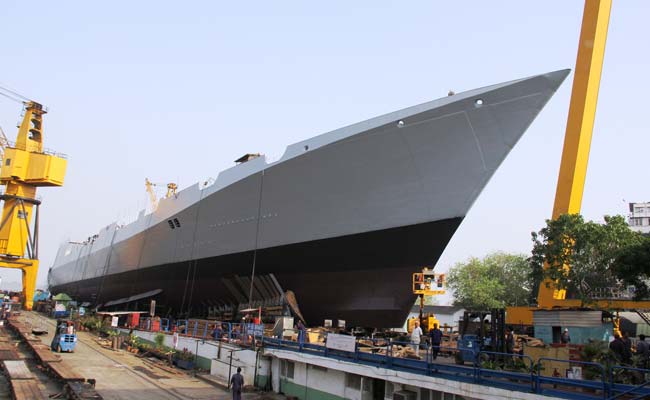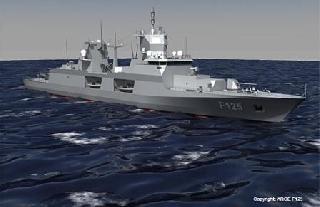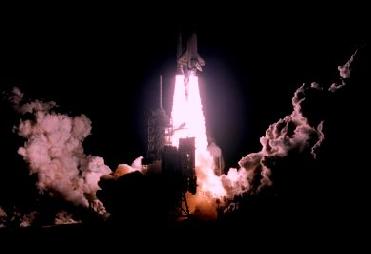
The hull of the Visakhapatnam, the latest destroyer being built for the Indian Navy.
NEW DELHI (PTI): Indian Navy's new destroyer, Visakhapatnam, with enhanced capability to operate in nuclear, biological and chemical atmosphere, will be launched in Mumbai on Sunday.
The ship is the first of the four follow follow-up order of the Kolkata class warships and will give a major flip to India's maritime capabilities when it is inducted in 2018.
Launch of the ship means that it is being put into the sea. The total cost of the project is little over Rs 29,600 Crores.
"Kolkata Class did not have a full-fledged Total Atmosphere Control System (TAC). The TAC system provides you with the capability of operating in a fall-out region, be it a nuclear, chemical or biological almost endlessly...because the complete air being taken inside is through nuclear, biological and chemical filters except in the machinery compartment," Rear Admiral A K Saxena, Director General (Naval Design) told reporters here.
Those entering the machinery compartment in a fall-out region will have to wear specialised masks to protect themselves.
The ship, named Visakhapatnam (Project 15 B), a stealth destroyer, is 65 percent indigenous and has a number of weapon systems which have been made at home.
At 7,300 tonnes, Visakhapatnam will be the largest destroyer commissioned by the Indian Navy and will be equipped with the Israeli Multi Function Surveillance Threat Alert Radar (MF-STAR).
This will provide targeting information to 32 Barak 8 long-range surface to air missiles onboard the warship, that is being co-developed by India with Israel.
The Barak 8 missile is being integrated in to the Navy's new destroyer, INS Kolkata and will be test-fired by October, Navy officials said.
The ship will also be carrying BRAHMOS supersonic cruise missiles.
Project 15-A and Project 15-B will share the same hull-design and Ukrainian-built Zorya gas turbines.
Navy officials said the Visakhapatnam is likely to be inducted in the Indian Navy by 2018.
Four guided missile destroyers of Project 15B are under construction at Mazagaon Dock Limited at a cost of Rs 29,643.74 crore.
These ships are amongst the most technologically advanced Guided Missile Destroyers of the world, with state of the art weapon/sensor package, advanced stealth features and a high degree of automation.
The design of P-15B ships has been developed in house by the Directorate of Naval Design (Surface Ship Group).
With a displacement of 7300 tons, each ship will be spanning 163 meters in length and 17.4 meters at the beam.
These ships will be propelled by four gas turbines in Combined Gas and Gas (COGAG) configuration. The ships are capable of achieving speeds in excess of 30 knots and have maximum endurance of 4000 nm at economical speed of 14 knots.
The P-15B destroyers incorporate new design concepts for improved survivability, sea keeping, stealth and ship manoeuvrability. These ships will be equipped to carry and operate two multiple role helicopters.
State of art rail less helo traversing system is being introduced for efficient helicopter handling onboard.
These ships would be equipped with Integrated Platform Management System (IPMS), Ship Data Network (SDN), Automatic Power Management System (APMS) and Combat Management System (CMS).
While control and monitoring of machinery and auxiliaries is achieved through the IPMS, power management is done using the APMS.
The CMS performs threat evaluation and resource allocation based on the tactical picture compiled and ammunition available onboard. The SDN is the information highway on which data from all the sensors and weapons ride.
Stealth has been a major thrust area in P15B design.
Enhanced stealth features have been achieved through shaping of hull and use of radar transparent deck fittings which make these ships difficult to detect.
The ship embodies features such as Multiple Fire zones, Battle Damage Control Systems (BDCS), Distributional Power Systems and Emergency DA to enhance survivability and reliability in emergent scenarios.
These ships have been designed for a complement of 50 officers and 250 sailors.
The ship's fire power consists of sophisticated weapons-sensor suite including vertically launch capable Surface to Air (SAM) and Surface-to-Surface Missiles (SSM) for long distance engagement of shore and sea based targets.
It is also noteworthy that this ship has significantly high indigenous content (about 65 per cent), in the form of weapons, machinery and material.
 Previous Article
Previous Article Next Article
Next Article












The Indian Air Force, in its flight trials evaluation report submitted before the Defence Ministry l..
view articleAn insight into the Medium Multi-Role Combat Aircraft competition...
view articleSky enthusiasts can now spot the International Space Station (ISS) commanded by Indian-American astr..
view article